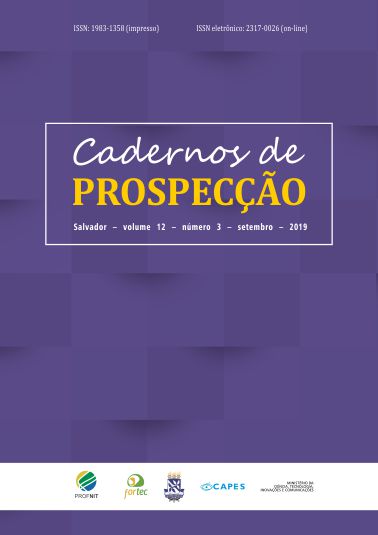Prospect Study in Computational Chemistry
DOI:
https://doi.org/10.9771/cp.v12i3.27314Keywords:
Computational Chemistry, Intellectual Property, Patents.Abstract
Computational chemistry is an area of chemistry in growing, making use, among others, of quantum chemistry and molecular mechanics methods to investigate in detail chemical processes. Due to the increase in processing and storage capacity of computers, together with development of more efficient algorithms, computational chemistry is currently an attractive tool for studies in physics, engineering, materials and biology. If on the one hand computational chemistry occupies a prominent place in academic research, same is not true in the field of intellectual protection. However, due to the multidisciplinary nature, we believe that computational chemist can contribute to generation of technological products. Therefore, the main aim of this work was to analyze, through a survey of the patent deposit, the current scenario involving the application of computational chemistry in studies of commercial interest. Collected data evidenced a negative reality in this scenario, which can generate a vast field to be explored.
Downloads
References
CRAMER, C. J. Essentials of Computational Chemistry: Theories and Models. 2. ed. [S.I]: John Wiley & Sons, 2004.
FRENKEL, D.; SMIT, B. Understanding Molecular Simulation: From Algorithms To Applications. 2. ed. [S.I]: Academic Press, 2002.
GOMEZ-GUALDRON, D. A. et al. Computational Design of Metal-Organic Frameworks Based on Stable Zirconium Building Units for Storage and Delivery of Methane. Chem. Mater. v. 26, n. 19, p. 5.632-5.639, 2014.
GREELEY, J. Theoretical Heterogeneous Catalysis: Scaling Relationships and Computational Catalyst Design. Annu. Rev. Chem. Biomol. Eng., v. 7, p. 605-635, 2016.
HEAD-GORDON, M. Quantum Chemistry and Molecular Processes. J. Phys. Chem., v. 100, n. 31, p. 13.213-13.225, 1996.
LESZCZYNSKI, J. Computational Chemistry: Reviews of Current Trends. [S.I]: World Scientific, 2003. v.8.
LÓPEZ-CAMACHO, C. et al. Rational Zika Vaccine Design Via The Modulation Of Antigen Membrane Anchors In Chimpanzee Adenoviral Vectors. Nature Communications, v. 9, p. 2.441, 2018.
MADURA, J. D.; UL-HAQ, Z. Frontiers in Computational Chemistry. [S.I]: Bentham Science, 2016. v. 1.
MORGON, N. H.; COUTINHO, Kaline. Métodos de Química Teórica e Modelagem Molecular. São Paulo: Livraria da Física, 2007.
PARR, R. G.; WEITAO, Y. Density-Functional Theory of Atoms and Molecules. New York: Oxford University Press, 1994.
RAPAPORT, D. C. The Art of Molecular Dynamics Simulation. Cambridge: Cambridge University Press, 2004.
RAPPÉ, A. K.; CASEWIT, C. J. Molecular Mechanics Across Chemistry. New York: University Science Books, 1997.
STEWART, J. J. P. In Reviews in Computational Chemistry. [S.I]: John Wiley & Sons, 2007. 45 p. v. 1.
SZABO, A.; OSTLUND, N. S. Modern Quantum Chemistry: Introduction to Advanced Electronic Structure Theory. [S.I]: Dover Publications, 1996.
Downloads
Published
How to Cite
Issue
Section
License
Copyright (c) 2019 Cadernos de Prospecção

This work is licensed under a Creative Commons Attribution-NonCommercial 4.0 International License.
O autor declara que: - Todos os autores foram nomeados. - Está submetendo o manuscrito com o consentimento dos outros autores. - Caso o trabalho submetido tiver sido contratado por algum empregador, tem o consentimento do referido empregador. - Os autores estão cientes de que é condição de publicação que os manuscritos submetidos a esta revista não tenham sido publicados anteriormente e não sejam submetidos ou publicados simultaneamente em outro periódico sem prévia autorização do Conselho Editorial. - Os autores concordam que o seu artigo ou parte dele possa ser distribuído e/ou reproduzido por qualquer forma, incluindo traduções, desde que sejam citados de modo completo esta revista e os autores do manuscrito. - Revista Cadernos de Prospecção está licenciado com uma Licença Creative Commons Attribution 4.0. Esta licença permite que outros remixem, adaptem e criem a partir do seu trabalho para fins não comerciais, e embora os novos trabalhos tenham de lhe atribuir o devido crédito e não possam ser usados para fins comerciais, os usuários não têm de licenciar esses trabalhos derivados sob os mesmos termos.
Este obra está licenciado com uma Licença Creative Commons Atribuição 4.0 Internacional.








